Pumping Station Desing - Second Edition by Robert L. Sanks, George Tchobahoglous, Garr M. Jones
Подождите немного. Документ загружается.

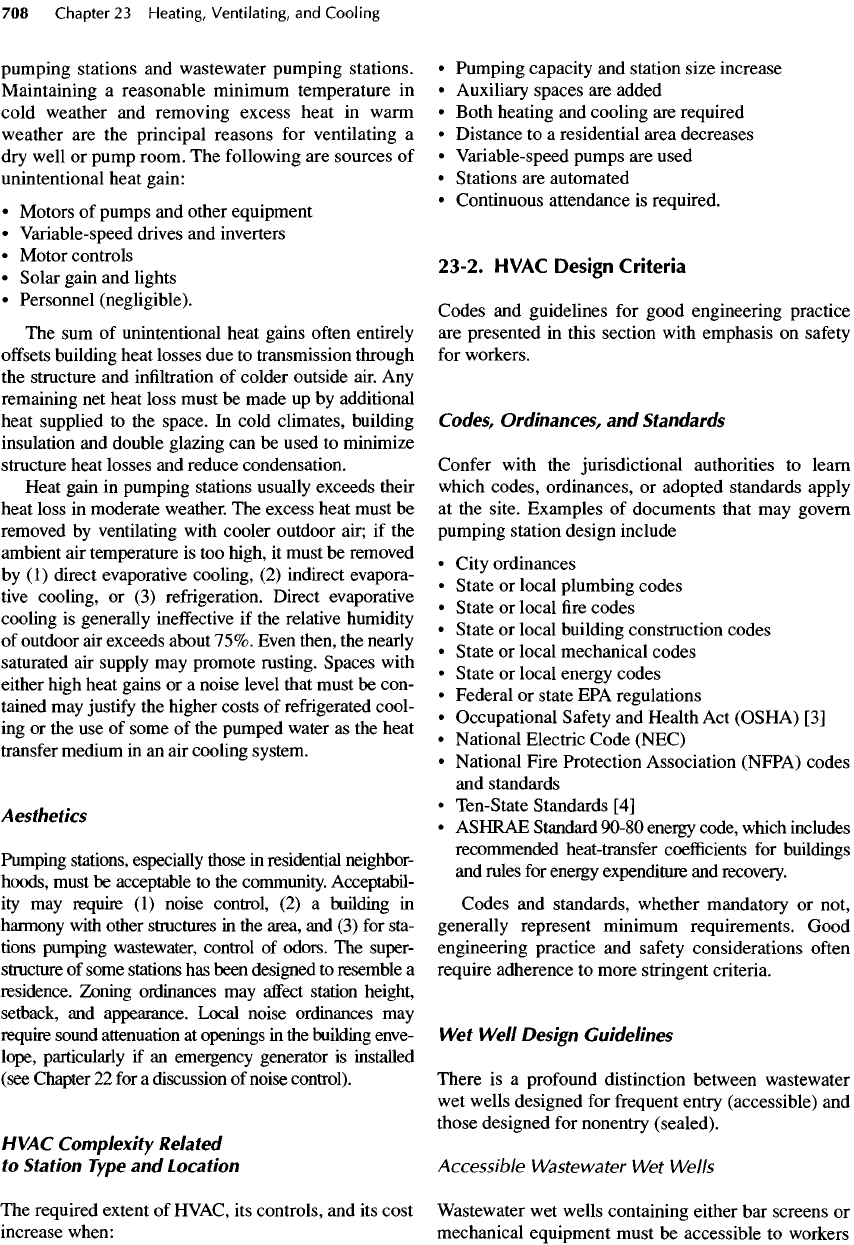
pumping
stations
and
wastewater pumping stations.
Maintaining
a
reasonable minimum temperature
in
cold weather
and
removing excess heat
in
warm
weather
are the
principal reasons
for
ventilating
a
dry
well
or
pump room.
The
following
are
sources
of
unintentional heat gain:
•
Motors
of
pumps
and
other equipment
•
Variable-speed drives
and
inverters
•
Motor controls
•
Solar gain
and
lights
•
Personnel (negligible).
The sum of
unintentional heat gains
often
entirely
offsets
building heat losses
due to
transmission through
the
structure
and
infiltration
of
colder outside air.
Any
remaining
net
heat loss must
be
made
up by
additional
heat supplied
to the
space.
In
cold climates, building
insulation
and
double glazing
can be
used
to
minimize
structure
heat losses
and
reduce condensation.
Heat gain
in
pumping stations usually exceeds their
heat
loss
in
moderate weather.
The
excess heat must
be
removed
by
ventilating with cooler outdoor air;
if the
ambient
air
temperature
is too
high,
it
must
be
removed
by
(1)
direct evaporative cooling,
(2)
indirect evapora-
tive
cooling,
or (3)
refrigeration. Direct evaporative
cooling
is
generally
ineffective
if the
relative humidity
of
outdoor
air
exceeds about 75%. Even then,
the
nearly
saturated
air
supply
may
promote rusting. Spaces with
either high heat gains
or a
noise level that must
be
con-
tained
may
justify
the
higher costs
of
refrigerated cool-
ing or the use of
some
of the
pumped water
as the
heat
transfer
medium
in an air
cooling system.
Aesthetics
Pumping
stations, especially those
in
residential neighbor-
hoods, must
be
acceptable
to the
community. Acceptabil-
ity
may
require
(1)
noise control,
(2) a
building
in
harmony
with
other structures
in the
area,
and (3) for
sta-
tions pumping wastewater, control
of
odors.
The
super-
structure
of
some stations
has
been designed
to
resemble
a
residence. Zoning ordinances
may
affect
station height,
setback,
and
appearance. Local noise ordinances
may
require
sound attenuation
at
openings
in the
building enve-
lope, particularly
if an
emergency generator
is
installed
(see Chapter
22 for a
discussion
of
noise control).
HVAC
Complexity
Related
to
Station
Type
and
Location
The
required extent
of
HVAC,
its
controls,
and its
cost
increase when:
•
Pumping capacity
and
station size increase
•
Auxiliary spaces
are
added
•
Both heating
and
cooling
are
required
•
Distance
to a
residential area decreases
•
Variable-speed pumps
are
used
•
Stations
are
automated
•
Continuous attendance
is
required.
23-2.
HVAC
Design
Criteria
Codes
and
guidelines
for
good engineering practice
are
presented
in
this section with emphasis
on
safety
for
workers.
Codes,
Ordinances,
and
Standards
Confer
with
the
jurisdictional
authorities
to
learn
which codes, ordinances,
or
adopted standards apply
at
the
site. Examples
of
documents that
may
govern
pumping station design include
•
City ordinances
•
State
or
local plumbing codes
•
State
or
local
fire
codes
•
State
or
local building construction codes
•
State
or
local mechanical codes
•
State
or
local energy codes
•
Federal
or
state
EPA
regulations
•
Occupational Safety
and
Health
Act
(OSHA)
[3]
•
National
Electric
Code (NEC)
•
National
Fire
Protection Association (NFPA) codes
and
standards
•
Ten-State Standards
[4]
•
ASHRAE Standard
90-80
energy code, which includes
recommended heat-transfer
coefficients
for
buildings
and
rules
for
energy expenditure
and
recovery.
Codes
and
standards, whether mandatory
or
not,
generally represent minimum requirements. Good
engineering practice
and
safety
considerations
often
require adherence
to
more stringent criteria.
Wet
Well
Design
Guidelines
There
is a
profound distinction between wastewater
wet
wells designed
for
frequent entry (accessible)
and
those designed
for
nonentry (sealed).
Accessible
Wastewater
Wet
Wells
Wastewater
wet
wells containing either
bar
screens
or
mechanical equipment must
be
accessible
to
workers
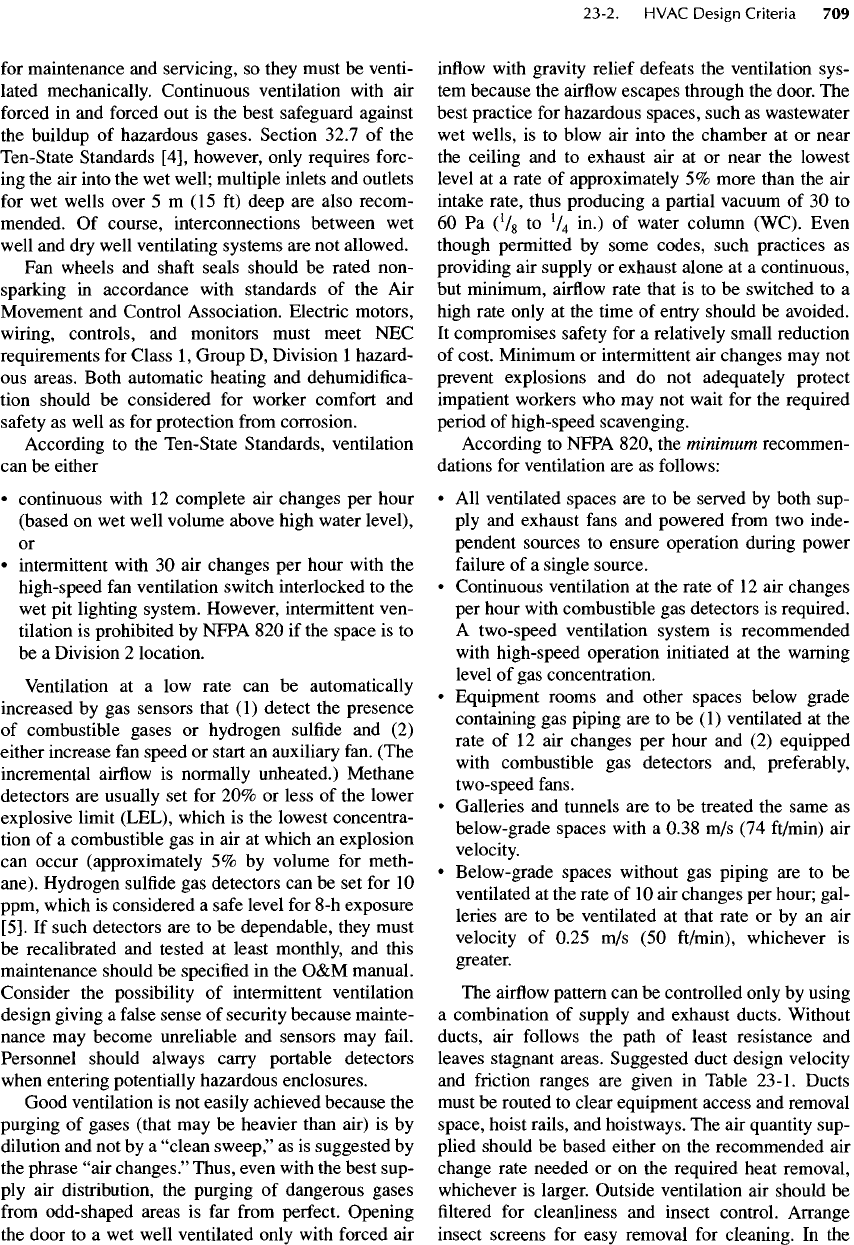
for
maintenance
and
servicing,
so
they must
be
venti-
lated mechanically. Continuous ventilation with
air
forced
in and
forced
out is the
best safeguard against
the
buildup
of
hazardous gases. Section 32.7
of the
Ten-State Standards [4], however, only requires
forc-
ing
the air
into
the wet
well; multiple inlets
and
outlets
for
wet
wells over
5 m (15 ft)
deep
are
also recom-
mended.
Of
course, interconnections between
wet
well
and dry
well ventilating systems
are not
allowed.
Fan
wheels
and
shaft
seals should
be
rated non-
sparking
in
accordance with standards
of the Air
Movement
and
Control Association. Electric motors,
wiring,
controls,
and
monitors must meet
NEC
requirements
for
Class
1,
Group
D,
Division
1
hazard-
ous
areas. Both automatic heating
and
dehumidifica-
tion
should
be
considered
for
worker comfort
and
safety
as
well
as for
protection
from
corrosion.
According
to the
Ten-State Standards, ventilation
can
be
either
•
continuous with
12
complete
air
changes
per
hour
(based
on wet
well volume above high water level),
or
•
intermittent with
30 air
changes
per
hour with
the
high-speed
fan
ventilation switch interlocked
to the
wet
pit
lighting system. However, intermittent ven-
tilation
is
prohibited
by
NFPA
820 if the
space
is to
be a
Division
2
location.
Ventilation
at a low
rate
can be
automatically
increased
by gas
sensors that
(1)
detect
the
presence
of
combustible gases
or
hydrogen
sulfide
and (2)
either increase
fan
speed
or
start
an
auxiliary fan. (The
incremental
airflow
is
normally unheated.) Methane
detectors
are
usually
set for 20% or
less
of the
lower
explosive limit (LEL), which
is the
lowest concentra-
tion
of a
combustible
gas in air at
which
an
explosion
can
occur (approximately
5% by
volume
for
meth-
ane). Hydrogen
sulfide
gas
detectors
can be set for 10
ppm,
which
is
considered
a
safe
level
for 8-h
exposure
[5].
If
such detectors
are to be
dependable, they must
be
recalibrated
and
tested
at
least monthly,
and
this
maintenance should
be
specified
in the O&M
manual.
Consider
the
possibility
of
intermittent ventilation
design giving
a
false
sense
of
security because mainte-
nance
may
become unreliable
and
sensors
may
fail.
Personnel should always carry portable detectors
when
entering potentially hazardous enclosures.
Good ventilation
is not
easily achieved because
the
purging
of
gases (that
may be
heavier than air)
is by
dilution
and not by a
"clean
sweep,"
as is
suggested
by
the
phrase "air changes." Thus, even with
the
best sup-
ply
air
distribution,
the
purging
of
dangerous gases
from
odd-shaped areas
is far
from
perfect. Opening
the
door
to a wet
well ventilated only with forced
air
inflow
with gravity relief defeats
the
ventilation sys-
tem
because
the
airflow
escapes through
the
door.
The
best
practice
for
hazardous spaces, such
as
wastewater
wet
wells,
is to
blow
air
into
the
chamber
at or
near
the
ceiling
and to
exhaust
air at or
near
the
lowest
level
at a
rate
of
approximately
5%
more than
the air
intake rate,
thus
producing
a
partial
vacuum
of 30 to
60 Pa
(V
8
to
V
4
in.)
of
water column (WC). Even
though
permitted
by
some codes, such practices
as
providing
air
supply
or
exhaust alone
at a
continuous,
but
minimum,
airflow
rate that
is to be
switched
to a
high rate only
at the
time
of
entry should
be
avoided.
It
compromises
safety
for a
relatively small reduction
of
cost.
Minimum
or
intermittent
air
changes
may not
prevent explosions
and do not
adequately protect
impatient workers
who may not
wait
for the
required
period
of
high-speed scavenging.
According
to
NFPA 820,
the
minimum recommen-
dations
for
ventilation
are as
follows:
• All
ventilated spaces
are to be
served
by
both sup-
ply and
exhaust
fans
and
powered
from
two
inde-
pendent sources
to
ensure operation during power
failure
of a
single source.
•
Continuous ventilation
at the
rate
of 12 air
changes
per
hour with combustible
gas
detectors
is
required.
A
two-
speed
ventilation system
is
recommended
with
high-speed operation initiated
at the
warning
level
of gas
concentration.
•
Equipment rooms
and
other spaces below grade
containing
gas
piping
are to be (1)
ventilated
at the
rate
of 12 air
changes
per
hour
and (2)
equipped
with
combustible
gas
detectors and, preferably,
two-speed
fans.
•
Galleries
and
tunnels
are to be
treated
the
same
as
below-grade
spaces with
a
0.38
m/s (74
ft/min)
air
velocity.
•
Below-grade spaces without
gas
piping
are to be
ventilated
at the
rate
of 10 air
changes
per
hour; gal-
leries
are to be
ventilated
at
that rate
or by an air
velocity
of
0.25
m/s (50
ft/min),
whichever
is
greater.
The
airflow
pattern
can be
controlled only
by
using
a
combination
of
supply
and
exhaust ducts. Without
ducts,
air
follows
the
path
of
least resistance
and
leaves stagnant areas. Suggested duct design velocity
and
friction ranges
are
given
in
Table
23-1.
Ducts
must
be
routed
to
clear equipment access
and
removal
space, hoist rails,
and
hoistways.
The air
quantity sup-
plied should
be
based
either
on the
recommended
air
change rate needed
or on the
required heat removal,
whichever
is
larger. Outside ventilation
air
should
be
filtered
for
cleanliness
and
insect control. Arrange
insect screens
for
easy removal
for
cleaning.
In the
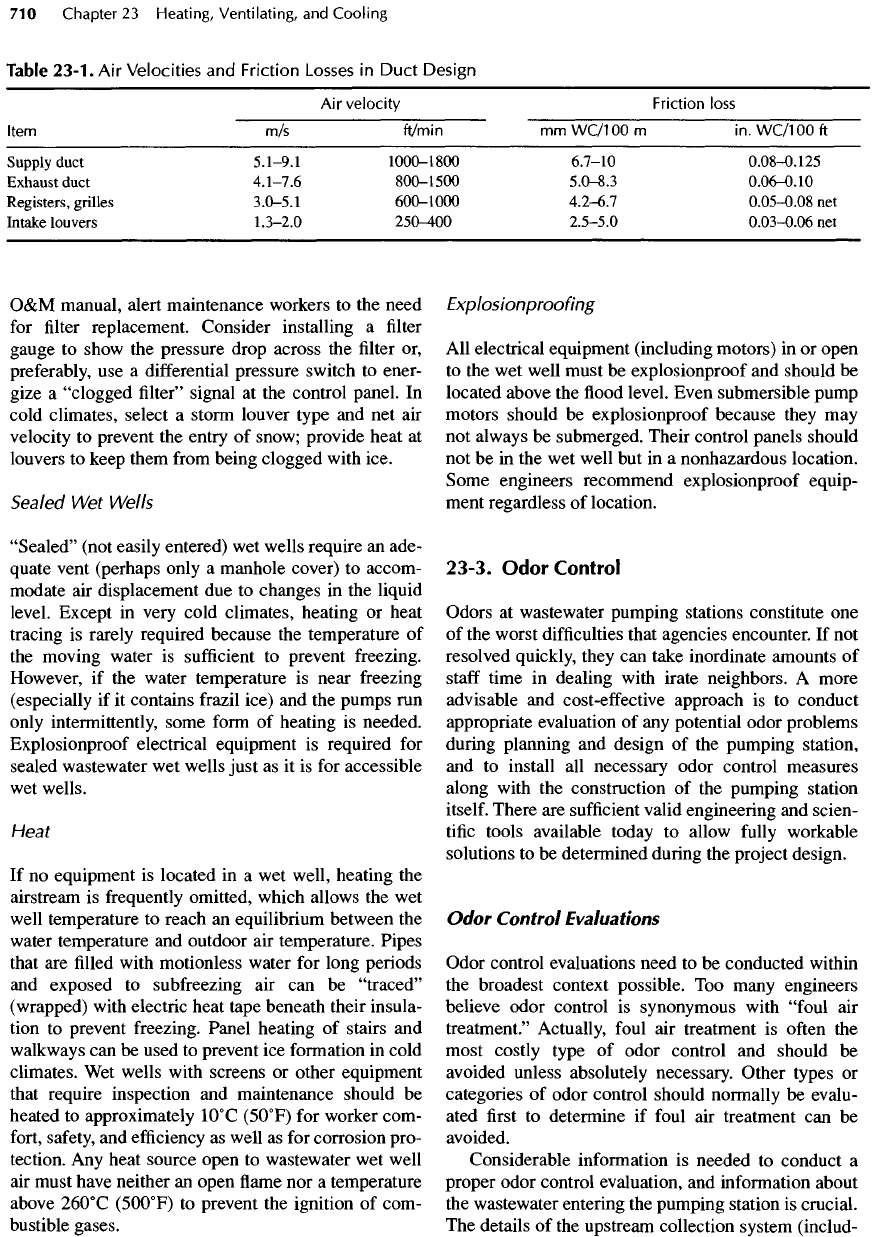
O&M
manual, alert maintenance workers
to the
need
for
filter
replacement. Consider installing
a
filter
gauge
to
show
the
pressure drop
across
the
filter
or,
preferably,
use a
differential
pressure switch
to
ener-
gize
a
"clogged filter" signal
at the
control panel.
In
cold climates, select
a
storm louver type
and net air
velocity
to
prevent
the
entry
of
snow; provide heat
at
louvers
to
keep them
from
being clogged with ice.
Sealed
Wet
Wells
"Sealed"
(not easily entered)
wet
wells require
an
ade-
quate
vent (perhaps only
a
manhole cover)
to
accom-
modate
air
displacement
due to
changes
in the
liquid
level. Except
in
very cold climates, heating
or
heat
tracing
is
rarely required because
the
temperature
of
the
moving water
is
sufficient
to
prevent
freezing.
However,
if the
water temperature
is
near freezing
(especially
if it
contains
frazil
ice)
and the
pumps
run
only
intermittently, some
form
of
heating
is
needed.
Explosionproof
electrical
equipment
is
required
for
sealed wastewater
wet
wells just
as it is for
accessible
wet
wells.
Heat
If
no
equipment
is
located
in a wet
well, heating
the
airstream
is
frequently
omitted, which allows
the wet
well
temperature
to
reach
an
equilibrium between
the
water
temperature
and
outdoor
air
temperature.
Pipes
that
are filled
with
motionless water
for
long periods
and
exposed
to
subfreezing
air can be
"traced"
(wrapped) with
electric
heat tape beneath their insula-
tion
to
prevent freezing. Panel heating
of
stairs
and
walkways
can be
used
to
prevent
ice
formation
in
cold
climates.
Wet
wells with
screens
or
other equipment
that
require inspection
and
maintenance should
be
heated
to
approximately
1O
0
C
(5O
0
F)
for
worker com-
fort,
safety,
and
efficiency
as
well
as for
corrosion pro-
tection.
Any
heat source open
to
wastewater
wet
well
air
must have neither
an
open
flame nor a
temperature
above
26O
0
C
(50O
0
F)
to
prevent
the
ignition
of
com-
bustible
gases.
Explosionproofing
All
electrical
equipment (including motors)
in or
open
to the wet
well must
be
explosionproof
and
should
be
located above
the flood
level. Even submersible pump
motors should
be
explosionproof because they
may
not
always
be
submerged. Their control panels should
not be in the wet
well
but in a
nonhazardous location.
Some engineers recommend explosionproof equip-
ment
regardless
of
location.
23-3.
Odor
Control
Odors
at
wastewater pumping stations constitute
one
of
the
worst
difficulties
that agencies encounter.
If not
resolved quickly, they
can
take inordinate amounts
of
staff
time
in
dealing with irate neighbors.
A
more
advisable
and
cost-effective approach
is to
conduct
appropriate evaluation
of any
potential odor problems
during planning
and
design
of the
pumping station,
and
to
install
all
necessary odor control measures
along with
the
construction
of the
pumping station
itself.
There
are
sufficient
valid engineering
and
scien-
tific
tools
available today
to
allow
fully
workable
solutions
to be
determined during
the
project design.
Odor
Control
Evaluations
Odor control evaluations need
to be
conducted within
the
broadest context possible.
Too
many engineers
believe odor control
is
synonymous with "foul
air
treatment." Actually,
foul
air
treatment
is
often
the
most costly type
of
odor control
and
should
be
avoided unless absolutely necessary.
Other
types
or
categories
of
odor control should normally
be
evalu-
ated
first to
determine
if
foul
air
treatment
can be
avoided.
Considerable information
is
needed
to
conduct
a
proper odor control evaluation,
and
information about
the
wastewater entering
the
pumping station
is
crucial.
The
details
of the
upstream collection system (includ-
Table
23-1.
Air
Velocities
and
Friction
Losses
in
Duct
Design
Air
velocity
Friction
loss
Item
m/s
ft/min
mm
WC/1OO
m
in.
WC/1OO
ft
Supply
duct
5.1-9.1
1000-1800
6.7-10
0.08-0.125
Exhaust
duct
4.1-7.6
800-1500
5.0-8.3
0.06-0.10
Registers,
grilles
3.0-5.1
600-1000
4.2-6.7
0.05-0.08
net
Intake
louvers
1.3-2.0
250-400
2.5-5.0
0.03-0.06
net

ing
operation
of
other pumping stations); sources,
kinds,
and
amounts
of
wastewater; industrial contribu-
tions;
and
other information
is
vital. Specific sampling
and
testing
of
existing wastewater
flows in the
same
area
as the
future
pumping station
are
likely
to be
helpful.
Several chapters
in WEF
Manual
22 [6] are
helpful
in
conducting such
an
evaluation.
See
also
ASCE Manual
69
[7].
Four odor control strategies
are
defined
and
dis-
cussed herein.
In
order
of
effectiveness,
they
are:
•
Minimizing
or
preventing production
of
odorous
compounds
•
Treating odorous compounds within
the
liquid phase
•
Containing
and
treating
foul
air
•
Enhancing atmospheric dispersion
of
foul
air.
A
well-organized evaluation
of
these categories
of
odor control almost always results
in a
successful
project. Operation
and
maintenance costs
as
well
as
first
cost must
be
evaluated
for
each strategy. Odorous
substances include
a
large variety
of
compounds.
The
reduced
sulfur
family
of
compounds
is the
major prob-
lem in
most wastewater systems,
and
hydrogen
sulfide
is the
most common
offender.
Various
effects
and
stan-
dards relating
to
hydrogen
sulfide
are
described
in
Table
23-2.
But
other
sulfides,
disulfides,
and
mercap-
tans
are
also
frequent
problem compounds, because
their odor thresholds
are
almost
all in the
part
per
bil-
lion
range
or
less. Reduced
sulfur
compounds, amines,
aldehydes,
ketones,
and
various organic acids
can
cause problems. Ammonia
is
only rarely
a
problem,
because
its
concentration
is
typically
low
compared
with
its
odor threshold.
The
concentration
of
odorants
can
be
measured
in the
liquid phase
as
well
as the gas
phase
for
almost
all
potential odorous compounds.
Liquid phase analysis
is
often
easier
to
complete
and
more accurate, whereas
gas
phase testing
can be
costly,
especially when scanning
for
large numbers
of
poten-
tially odorous organic compounds.
Minimizing
Odorous
Compounds
The first
line
of
defense against odor problems
is to
design
the
entire system
to
produce
the
absolute mini-
mum
quantity
of
odorous compounds allowed
to
enter
the
pumping station
via the
influent
water. Upstream
controls
may be
beyond
the
purview
of the
pumping
station designer,
but
they
may
need
to be
explored,
because
it
could
be
less costly
to
solve
the
problem
upstream. Control measures could include
the
follow-
ing:
•
Further pretreatment
of
specific
industrial
dis-
charges
to the
system.
•
Minimizing slug loads
of
wastewater
from
indus-
tries
or
other point sources.
• If
hydrogen
sulfide
is the
significant problem, keep-
ing
wastewater
pH
well above
7 to
minimize hydro-
gen
sulfide
off-gassing.
A pH of 8
would usually
be
adequate,
but pH 9
might
be
required sometimes.
•
Designing upstream sewers
to
maintain aerobic
conditions
in the
wastewater
—
usually
by
keeping
velocities above
1.5 m/s (5
ft/s).
•
Adding chemicals (such
as
ferrous
sulfate
or
ferric
chloride)
to
precipitate hydrogen
sulfide.
At
the
pumping station
itself,
there
should
be
mini-
mum
turbulence
of
wastewater, because turbulence
Table
23-2.
Effects
and
Standards
of
Hydrogen
Sulfide
Gas in the
Atmosphere
3
Concentration,
ppm by
volume
Effect
0.0005
Olfactory
detection threshold
0.003
Max
concentration
for
electronic equipment
per ISA
0.002-0.008
Practical odor threshold range
0.010
Max
concentration
for
electrical equipment
per
NEMA
0.030
Ambient
Air
Quality (odor-based) Standard
in
California
1
Offensive
odor; rotten
egg
smell
5
Deadens
olfactory
senses
10
Max
24-h
exposure
per
OSHA
15
Max 8-h
exposure
per
OSHA
10-50
Headache, nausea,
and
eye,
nose,
and
throat irritation
50 Max
30-min
exposure
per
OSHA
50-300
Eye and
respiratory
injury
300-500
Life
threatening; pulmonary edema
700
Immediate death
for
everyone
46,000
Lower explosive limit
a
Adapted
from
ASCE
Manual
69 [7] and
industry
standards.

promotes
off-gassing
of
odorous compounds. Drop
inlets into
the wet
well
can and
should
be
avoided.
In
stations with
constant-
speed
pumps,
use a
sloping
approach pipe
with
its
invert
at or
slightly below
the
low
water level even though
its
crown
may be
sub-
merged
at the
high water level (see Section 12-7).
Variable-
speed
pumping
is
most desirable (especially
in
larger stations where odor problems
are
more likely
and
the
investment more easily
justified),
because
matching
water elevations
in the
sewer
and wet
well
allows smooth, nonturbulent entry into
the wet
well.
Refer
to
Section 12-7
for
design details.
Wet
wells should
be
kept small enough
to
mini-
mize stagnation
and the
settling
of
solids. These
deposits
are
anaerobic
and
produce odorous com-
pounds
that
diffuse
into
the
liquid above
and
thence
into
the
air. Slime layers
form
on
submerged walls
of
wet
wells
and
also produce odors. Such wall areas
should also
be
minimized.
Wet
wells should
be
fre-
quently
(say, weekly) cleaned.
Refer
to
Section 12-7.
The
velocities needed
to
keep domestic wastewater
aerobic, promote scour,
and
eliminate odor-producing
deposits
in
pipes
are
given
in
ASCE Manual
69
[7].
In
general,
force
main velocities
of
1.1
to 1.2 m/s
(3.5
to
4.0
ft/s) occurring
at
least once
per day are
advisable
(depending
on
pipe diameter)
to
minimize problems.
Treating
Odorous
Compounds
in the
Liquid Phase
There
are a
host
of
chemicals that
can be
added
to
wastewater
to
inhibit
or
treat odorous compounds,
thus
minimizing
off-gassing
and
subsequent odor
problems. Only
the
broad categories
of
such chemi-
cals
are
defined
here:
•
Oxidants, such
as
chlorine, sodium
hypochlorite,
and
hydrogen peroxide. These chemicals oxidize
sulfide
(and perhaps other compounds) that already
exist
in
solution,
and
they minimize additional gen-
eration
for a
limited time downstream.
•
Precipitants (such
as
ferrous
or
ferric
chloride) that
precipitate
sulfide
as
insoluble, dark-colored com-
pounds. Reactions usually take
15
to 20
minutes.
•
Inhibitors, such
as
high
pH
slugs
(pH
greater than
12
for 20
minutes)
or
anthroquinone slugs, greatly
inhibit
sulfate-reducing bacteria densities
for a 1- to
2-week period. Continuous addition
of
nitrate com-
pounds
is
sometimes advantageous
to
promote
nitrate
reduction
and
minimize
sulfate
reduction.
•
Aerobic conditioning
by the
addition
of air or
high-
purity
oxygen.
If
more than about
0.5 to
1
.0
mg/1
of
dissolved oxygen
is
kept
in the
wastewater, little
anaerobic activity
can
take place
to
form
the
reduced,
offensive
compounds.
In
gravity sewers,
it
is
difficult
to add
dissolved oxygen except
by
natu-
ral
re-aeration
of
wastewater
flowing at
velocities
in
excess
of 1 m/s
(3.3
ft/s).
In
some force mains (with
certain
rising
profiles,
sufficient
pressure,
and
com-
patible
pipe materials),
it is
feasible
and
cost
effec-
tive
to add
high-purity oxygen.
•
Bases such
as
lime
or
caustic added continuously
to
keep
pH
above
8.5
minimizes hydrogen
sulfide
pro-
duction
and
off-gassing.
Chemicals, their reaction times,
and
transit times
through
the
facilities must
be
carefully
evaluated
[6,
7,
8],
Chemicals
can be
added
far
upstream,
at the wet
well,
or at the
discharge
of the
force main.
Containing
and
Treating Foul
Air
The first
step
in
designing
a
foul
air
treatment system
is
to
develop
a
reliable containment
and
ventilation
system that brings
all
foul
air to the
treatment device.
Containment
of
foul
air is not
always easy with sewers
bringing gases into
the wet
well,
and
doors
or
hatches
being opened.
But
regulating
fans
on
both inlet
and
exhaust
to
maintain
the
slight vacuum described
in
Section 23-2 helps,
as
does proper dispersal
of
incom-
ing
air at the
ceiling
and
collection
of
foul
air at the
floor.
Various
ventilation, corrosion,
safety,
and
related
issues
are
discussed separately
in
this chapter.
A
large
variation
in
pollutant concentration over
the
course
of
the day
sometimes results
in
poor treatment, unless
the
system
is
specifically designed
for it.
Therefore,
details about upstream system characteristics
and
operation
are
critical.
Biological
Foul
Air
Treatment
Of
the
various types
of
biological
foul
air
treatment
systems,
the one
most applicable
to
pumping stations
is
bulk media
biofiltration.
That system involves
(1)
adsorbing odorants onto
the
surface
of
organic media
and
(2)
biologically oxidizing
the
odorous compounds
over time
via the
aerobic action
of
micro-organisms
that
live
on the
media surfaces.
The
media
is
usually
a
mixture
of
wood
or
bark chips, compost, soil, sand,
peat moss, and/or other materials.
The
moisture con-
tent
of the
media
is
critical
for the
biomass,
and the
retention time
of the
foul
air in the
media must
be
suf-
ficient
—
usually
30 to
120
seconds
of
empty
bed
con-
tact time.
Biofilters
can be
built within closed containers
or
built
in the
ground with open-air vertical discharge
at
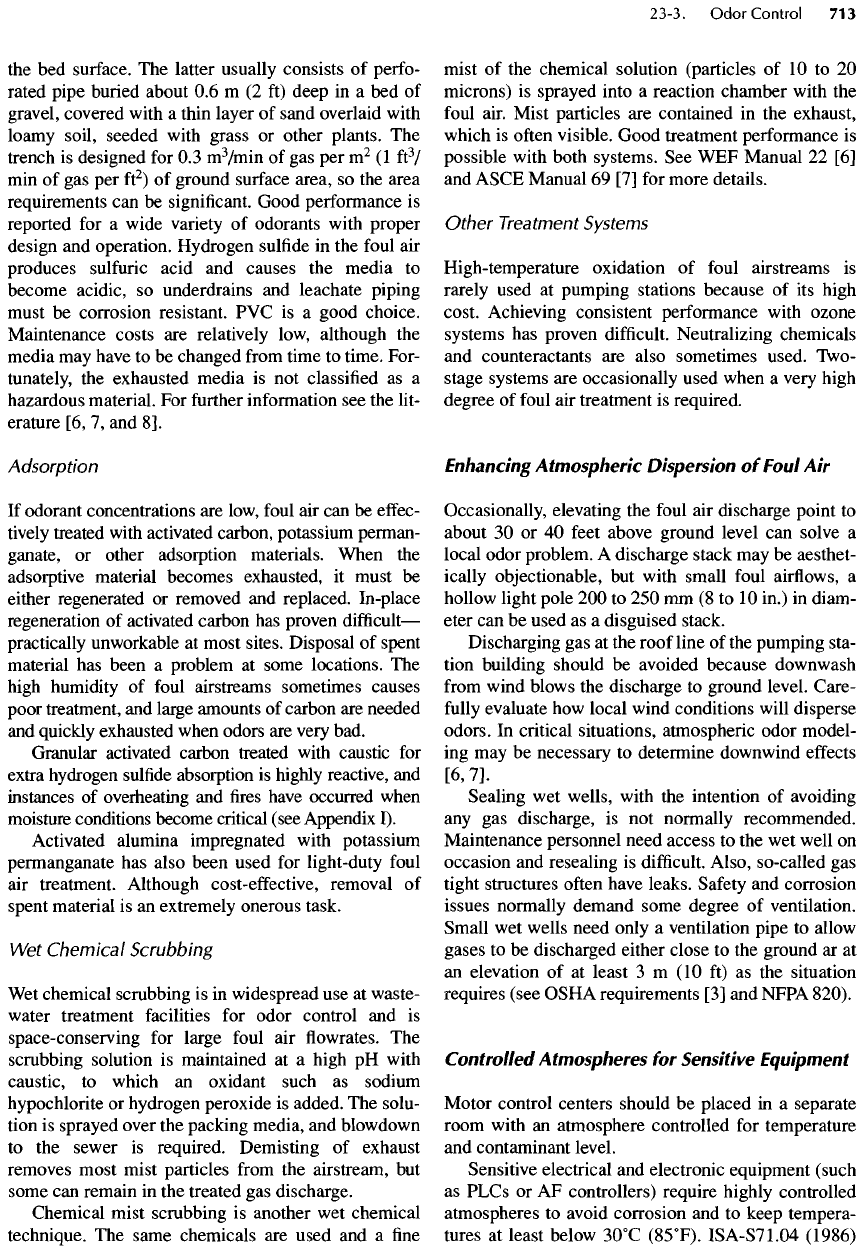
the bed
surface.
The
latter usually consists
of
perfo-
rated
pipe buried about
0.6
m
(2 ft)
deep
in a bed of
gravel,
covered with
a
thin layer
of
sand overlaid with
loamy
soil, seeded with grass
or
other plants.
The
trench
is
designed
for 0.3
m
3
/min
of gas per
m
2
(1
ft
3
/
min
of gas per
ft
2
)
of
ground
surface
area,
so the
area
requirements
can be
significant.
Good performance
is
reported
for a
wide variety
of
odorants with proper
design
and
operation. Hydrogen
sulfide
in the
foul
air
produces
sulfuric
acid
and
causes
the
media
to
become acidic,
so
underdrains
and
leachate piping
must
be
corrosion resistant.
PVC is a
good choice.
Maintenance
costs
are
relatively low, although
the
media
may
have
to be
changed
from
time
to
time. For-
tunately,
the
exhausted media
is not
classified
as a
hazardous
material.
For
further
information
see the
lit-
erature
[6,7,
and
8].
Adsorption
If
odorant concentrations
are
low,
foul
air can be
effec-
tively
treated
with
activated carbon, potassium perman-
ganate,
or
other adsorption materials. When
the
adsorptive
material becomes exhausted,
it
must
be
either regenerated
or
removed
and
replaced.
In-place
regeneration
of
activated carbon
has
proven
difficult
—
practically
unworkable
at
most sites. Disposal
of
spent
material
has
been
a
problem
at
some locations.
The
high
humidity
of
foul
airstreams sometimes causes
poor treatment,
and
large amounts
of
carbon
are
needed
and
quickly exhausted when odors
are
very bad.
Granular
activated carbon treated with caustic
for
extra
hydrogen
sulfide
absorption
is
highly reactive,
and
instances
of
overheating
and fires
have occurred when
moisture
conditions become critical (see Appendix
I).
Activated
alumina impregnated
with
potassium
permanganate
has
also been used
for
light-duty
foul
air
treatment. Although cost-effective, removal
of
spent material
is an
extremely onerous task.
Wet
Chemical
Scrubbing
Wet
chemical scrubbing
is in
widespread
use at
waste-
water
treatment facilities
for
odor control
and is
space-conserving
for
large
foul
air flowrates. The
scrubbing
solution
is
maintained
at a
high
pH
with
caustic,
to
which
an
oxidant such
as
sodium
hypochlorite
or
hydrogen peroxide
is
added.
The
solu-
tion
is
sprayed over
the
packing media,
and
blowdown
to the
sewer
is
required. Demisting
of
exhaust
removes
most mist particles
from
the
airstream,
but
some
can
remain
in the
treated
gas
discharge.
Chemical mist scrubbing
is
another
wet
chemical
technique.
The
same chemicals
are
used
and a fine
mist
of the
chemical solution (particles
of 10 to 20
microns)
is
sprayed into
a
reaction chamber with
the
foul
air. Mist
particles
are
contained
in the
exhaust,
which
is
often
visible. Good treatment performance
is
possible with both systems.
See WEF
Manual
22 [6]
and
ASCE Manual
69 [7] for
more
details.
Other
Treatment
Systems
High-temperature oxidation
of
foul
airstreams
is
rarely used
at
pumping stations because
of its
high
cost. Achieving consistent performance with ozone
systems
has
proven
difficult.
Neutralizing chemicals
and
counteractants
are
also sometimes used. Two-
stage systems
are
occasionally used when
a
very high
degree
of
foul
air
treatment
is
required.
Enhancing
Atmospheric
Dispersion
of
Foul
Air
Occasionally, elevating
the
foul
air
discharge point
to
about
30 or 40
feet
above ground level
can
solve
a
local odor problem.
A
discharge stack
may be
aesthet-
ically objectionable,
but
with small
foul
airflows,
a
hollow light pole
200 to 250 mm (8 to 10
in.)
in
diam-
eter
can be
used
as a
disguised stack.
Discharging
gas at the
roof line
of the
pumping sta-
tion building should
be
avoided because downwash
from
wind blows
the
discharge
to
ground level. Care-
fully
evaluate
how
local wind conditions will disperse
odors.
In
critical
situations, atmospheric odor model-
ing may be
necessary
to
determine downwind
effects
[6,7].
Sealing
wet
wells, with
the
intention
of
avoiding
any
gas
discharge,
is not
normally recommended.
Maintenance personnel need access
to the wet
well
on
occasion
and
resealing
is
difficult.
Also, so-called
gas
tight
structures
often
have leaks.
Safety
and
corrosion
issues normally demand some degree
of
ventilation.
Small
wet
wells need only
a
ventilation pipe
to
allow
gases
to be
discharged either close
to the
ground
ar at
an
elevation
of at
least
3 m (10 ft) as the
situation
requires (see OSHA requirements
[3] and
NFPA 820).
Controlled
Atmospheres
for
Sensitive
Equipment
Motor control centers should
be
placed
in a
separate
room with
an
atmosphere controlled
for
temperature
and
contaminant level.
Sensitive electrical
and
electronic equipment (such
as
PLCs
or AF
controllers) require highly controlled
atmospheres
to
avoid corrosion
and to
keep tempera-
tures
at
least below
3O
0
C
(85
0
F).
ISA-S71.04 (1986)
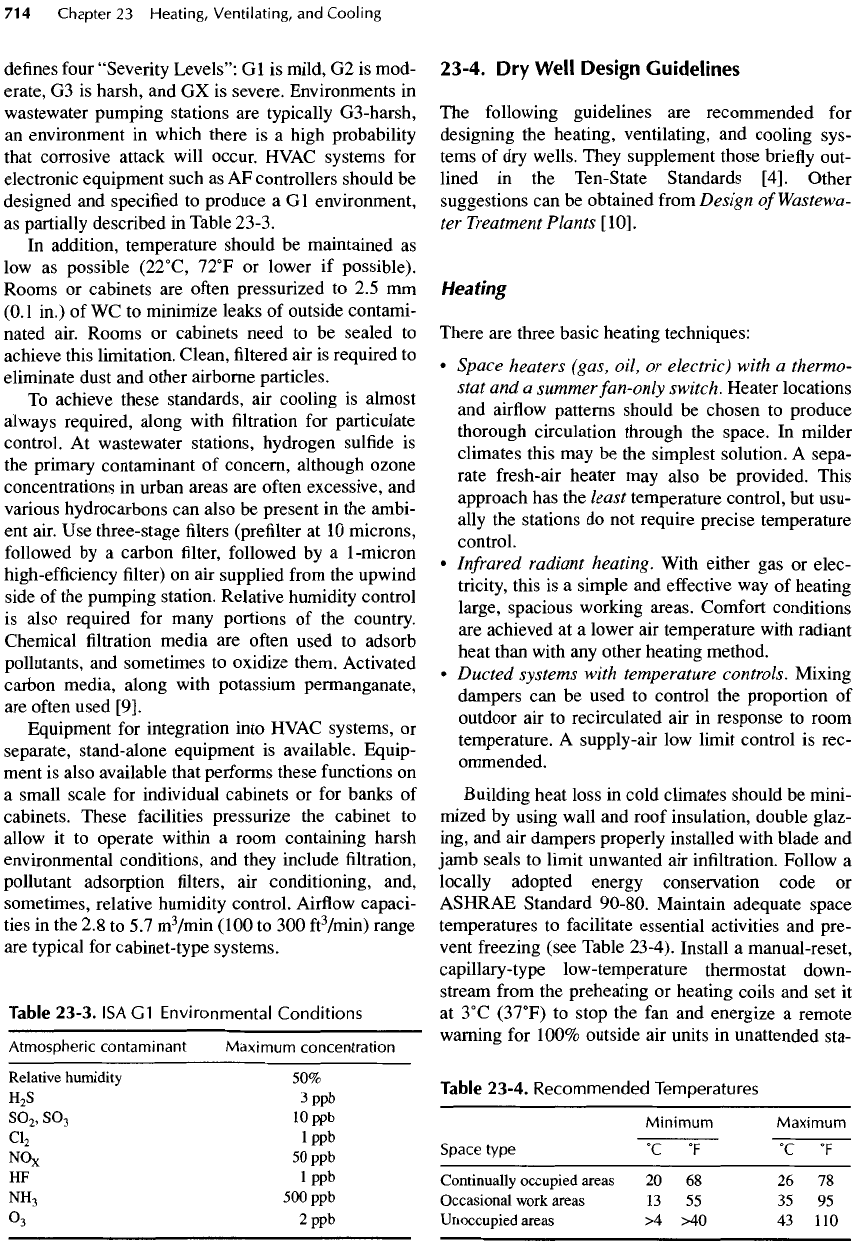
defines
four
"Severity
Levels":
Gl is
mild,
G2 is
mod-
erate,
G3 is
harsh,
and GX is
severe. Environments
in
wastewater pumping stations
are
typically
G3
-harsh,
an
environment
in
which there
is a
high probability
that
corrosive attack will occur.
HVAC
systems
for
electronic equipment such
as AF
controllers should
be
designed
and
specified
to
produce
a Gl
environment,
as
partially described
in
Table 23-3.
In
addition, temperature should
be
maintained
as
low
as
possible
(22
0
C,
72
0
F
or
lower
if
possible).
Rooms
or
cabinets
are
often
pressurized
to 2.5 mm
(0.
1
in.)
of WC to
minimize leaks
of
outside contami-
nated air. Rooms
or
cabinets need
to be
sealed
to
achieve this limitation. Clean,
filtered air is
required
to
eliminate dust
and
other airborne particles.
To
achieve these standards,
air
cooling
is
almost
always
required, along with
filtration for
particulate
control.
At
wastewater stations, hydrogen
sulfide
is
the
primary contaminant
of
concern, although ozone
concentrations
in
urban areas
are
often
excessive,
and
various
hydrocarbons
can
also
be
present
in the
ambi-
ent
air.
Use
three-stage
filters
(prefilter
at 10
microns,
followed
by a
carbon
filter,
followed
by a
1
-micron
high-efficiency
filter) on air
supplied
from
the
upwind
side
of the
pumping station. Relative humidity control
is
also required
for
many portions
of the
country.
Chemical
filtration
media
are
often
used
to
adsorb
pollutants,
and
sometimes
to
oxidize them. Activated
carbon media, along with potassium permanganate,
are
often
used
[9].
Equipment
for
integration into HVAC systems,
or
separate, stand-alone equipment
is
available. Equip-
ment
is
also available that performs these
functions
on
a
small scale
for
individual cabinets
or for
banks
of
cabinets. These facilities pressurize
the
cabinet
to
allow
it to
operate within
a
room containing harsh
environmental conditions,
and
they include
filtration,
pollutant
adsorption
filters, air
conditioning, and,
sometimes, relative humidity control.
Airflow
capaci-
ties
in the 2.8 to 5.7
m
3
/min
(100
to 300
ft
3
/min)
range
are
typical
for
cabinet-
type
systems.
Table
23-3.
ISA G1
Environmental
Conditions
Atmospheric
contaminant
Maximum
concentration
Relative
humidity
50%
H
2
S
3 ppb
SO
2
,
SO
3
10 ppb
Cl
2
1 ppb
NO
x
50 ppb
HF
1 ppb
NH
3
500 ppb
Os
2 ppb
23-4.
Dry
Well
Design
Guidelines
The
following guidelines
are
recommended
for
designing
the
heating, ventilating,
and
cooling sys-
tems
of dry
wells. They supplement those
briefly
out-
lined
in the
Ten-State Standards
[4].
Other
suggestions
can be
obtained
from
Design
of
Wastewa-
ter
Treatment
Plants
[1O].
Heating
There
are
three basic heating techniques:
•
Space
heaters (gas, oil,
or
electric) with
a
thermo-
stat
and a
summer
fan-
only
switch.
Heater locations
and
airflow
patterns should
be
chosen
to
produce
thorough circulation through
the
space.
In
milder
climates this
may be the
simplest solution.
A
sepa-
rate fresh-air heater
may
also
be
provided. This
approach
has the
least temperature control,
but
usu-
ally
the
stations
do not
require
precise
temperature
control.
•
Infrared
radiant heating. With either
gas or
elec-
tricity, this
is a
simple
and
effective
way of
heating
large, spacious working areas. Comfort conditions
are
achieved
at a
lower
air
temperature with radiant
heat than with
any
other heating method.
•
Ducted systems with temperature controls. Mixing
dampers
can be
used
to
control
the
proportion
of
outdoor
air to
recirculated
air in
response
to
room
temperature.
A
supply-air
low
limit control
is
rec-
ommended.
Building
heat loss
in
cold climates should
be
mini-
mized
by
using wall
and
roof insulation, double glaz-
ing,
and air
dampers properly installed with blade
and
jamb seals
to
limit unwanted
air
infiltration. Follow
a
locally adopted energy conservation code
or
ASHRAE Standard
90-80.
Maintain adequate space
temperatures
to
facilitate essential activities
and
pre-
vent
freezing (see Table 23-4). Install
a
manual-reset,
capillary-type low-temperature thermostat down-
stream
from
the
preheating
or
heating
coils
and set it
at
3
0
C
(37
0
F)
to
stop
the fan and
energize
a
remote
warning
for
100% outside
air
units
in
unattended sta-
Table
23-4.
Recommended
Temperatures
Minimum
Maximum
Space type
0
C
0
F
0
C
0
F
Continually
occupied areas
20 68 26 78
Occasional
work areas
13 55 35 95
Unoccupied
areas
>4 >40 43
110
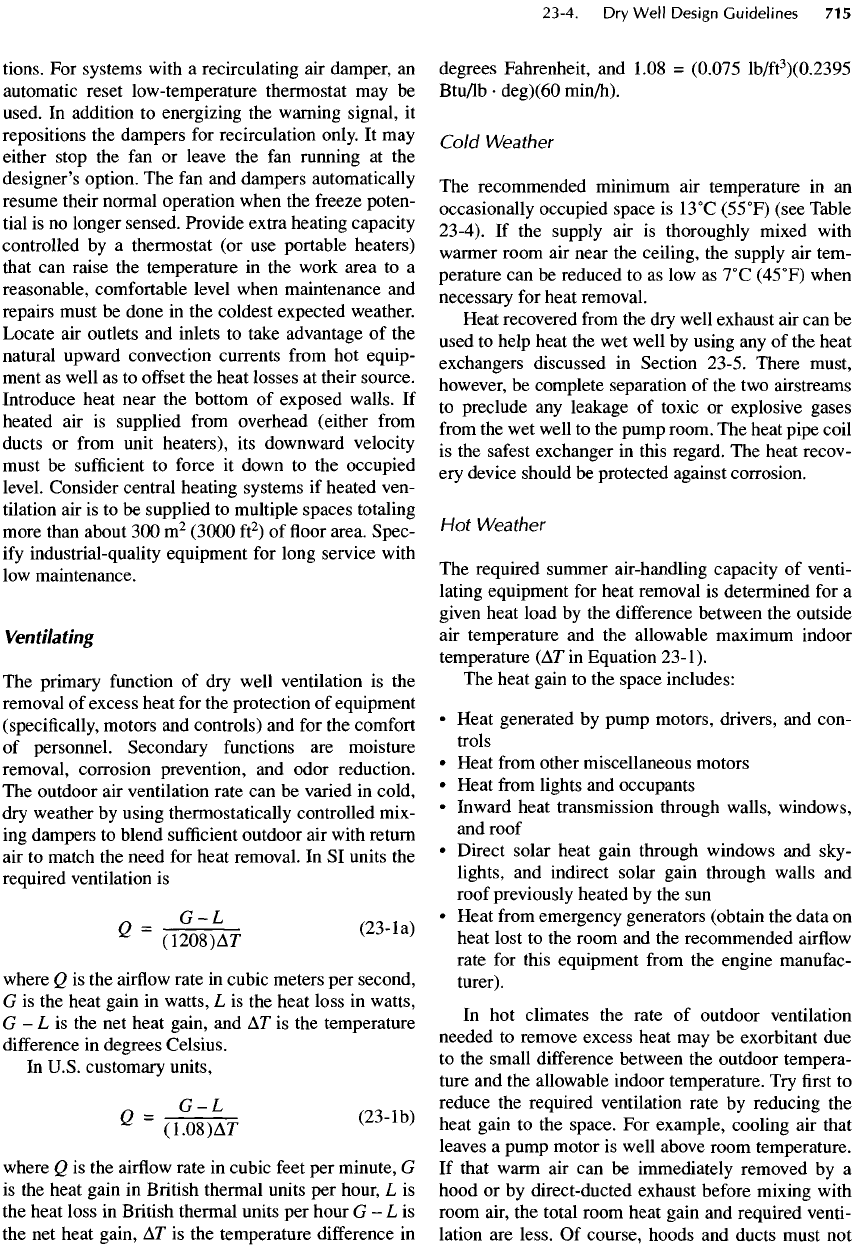
tions.
For
systems
with
a
recirculating
air
damper,
an
automatic
reset low-temperature thermostat
may be
used.
In
addition
to
energizing
the
warning signal,
it
repositions
the
dampers
for
recirculation only.
It may
either stop
the fan or
leave
the fan
running
at the
designer's
option.
The fan and
dampers automatically
resume
their normal operation when
the
freeze
poten-
tial
is no
longer sensed. Provide extra heating capacity
controlled
by a
thermostat
(or use
portable heaters)
that
can
raise
the
temperature
in the
work area
to a
reasonable, comfortable level when maintenance
and
repairs must
be
done
in the
coldest expected weather.
Locate
air
outlets
and
inlets
to
take advantage
of the
natural
upward
convection currents
from
hot
equip-
ment
as
well
as to
offset
the
heat losses
at
their source.
Introduce
heat near
the
bottom
of
exposed walls.
If
heated
air is
supplied
from
overhead (either
from
ducts
or
from
unit
heaters),
its
downward velocity
must
be
sufficient
to
force
it
down
to the
occupied
level. Consider central heating systems
if
heated ven-
tilation
air is to be
supplied
to
multiple spaces totaling
more than about
300
m
2
(3000
ft
2
)
of floor
area. Spec-
ify
industrial-quality equipment
for
long service
with
low
maintenance.
Ventilating
The
primary
function
of dry
well ventilation
is the
removal
of
excess heat
for the
protection
of
equipment
(specifically,
motors
and
controls)
and for the
comfort
of
personnel. Secondary
functions
are
moisture
removal, corrosion prevention,
and
odor reduction.
The
outdoor
air
ventilation rate
can be
varied
in
cold,
dry
weather
by
using thermostatically controlled mix-
ing
dampers
to
blend
sufficient
outdoor
air
with return
air to
match
the
need
for
heat removal.
In SI
units
the
required ventilation
is
Q
=
(12OS)AT
(23
-
la)
where
Q is the
airflow
rate
in
cubic meters
per
second,
G is the
heat gain
in
watts,
L is the
heat loss
in
watts,
G
- L is the net
heat gain,
and AT is the
temperature
difference
in
degrees Celsius.
In
U.S. customary units,
Q
=
(I
0
O
8
)Ir
(23
-
lb)
where
Q is the
airflow
rate
in
cubic
feet
per
minute,
G
is the
heat gain
in
British thermal units
per
hour,
L is
the
heat
loss
in
British thermal units
per
hour
G - L is
the net
heat gain,
AT
is the
temperature
difference
in
degrees Fahrenheit,
and
1.08
=
(0.075
Ib/ft
3
)(0.2395
BtuAb
-
deg)(60
min/h).
Cold
Weather
The
recommended minimum
air
temperature
in an
occasionally occupied space
is
13
0
C
(55
0
F)
(see Table
23-4).
If the
supply
air is
thoroughly mixed with
warmer
room
air
near
the
ceiling,
the
supply
air
tem-
perature
can be
reduced
to as low as
7
0
C
(45
0
F)
when
necessary
for
heat removal.
Heat recovered
from
the dry
well exhaust
air can be
used
to
help heat
the wet
well
by
using
any of the
heat
exchangers discussed
in
Section 23-5. There must,
however,
be
complete
separation
of the two
airstreams
to
preclude
any
leakage
of
toxic
or
explosive gases
from
the wet
well
to the
pump room.
The
heat pipe coil
is
the
safest
exchanger
in
this regard.
The
heat recov-
ery
device should
be
protected against corrosion.
Hot
Weather
The
required summer air-handling capacity
of
venti-
lating equipment
for
heat removal
is
determined
for a
given
heat load
by the
difference
between
the
outside
air
temperature
and the
allowable maximum indoor
temperature
(AT
in
Equation
23-1).
The
heat gain
to the
space includes:
•
Heat generated
by
pump motors, drivers,
and
con-
trols
•
Heat
from
other miscellaneous motors
•
Heat
from
lights
and
occupants
•
Inward heat transmission through walls, windows,
and
roof
•
Direct solar heat gain through windows
and
sky-
lights,
and
indirect solar gain through walls
and
roof previously heated
by the sun
•
Heat
from
emergency generators (obtain
the
data
on
heat lost
to the
room
and the
recommended
airflow
rate
for
this equipment
from
the
engine
manufac-
turer).
In
hot
climates
the
rate
of
outdoor ventilation
needed
to
remove excess heat
may be
exorbitant
due
to the
small
difference
between
the
outdoor tempera-
ture
and the
allowable indoor temperature.
Try first to
reduce
the
required ventilation rate
by
reducing
the
heat gain
to the
space.
For
example, cooling
air
that
leaves
a
pump motor
is
well above room temperature.
If
that warm
air can be
immediately removed
by a
hood
or by
direct-ducted
exhaust before mixing with
room air,
the
total room heat gain
and
required venti-
lation
are
less.
Of
course, hoods
and
ducts must
not
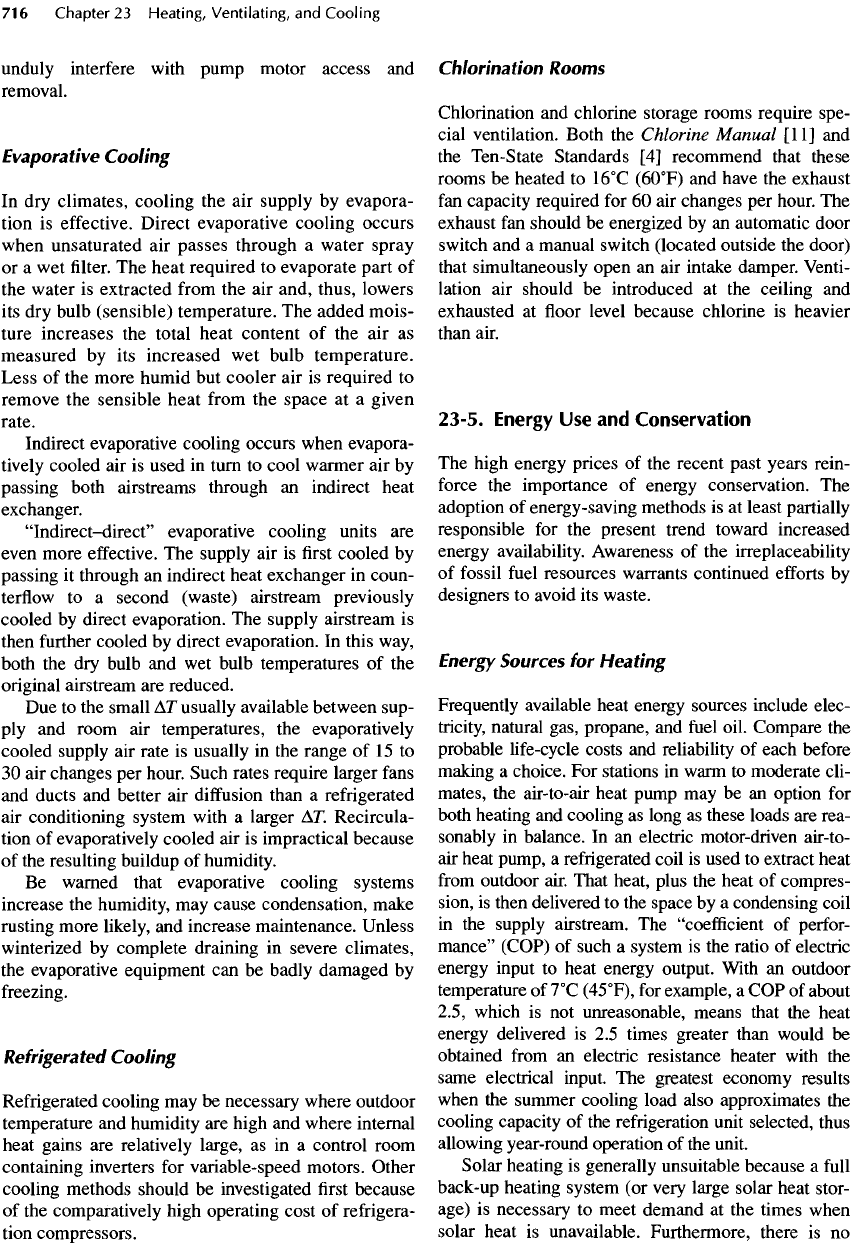
unduly
interfere with pump
motor
access
and
removal.
Evaporative
Cooling
In
dry
climates, cooling
the air
supply
by
evapora-
tion
is
effective.
Direct
evaporative
cooling
occurs
when
unsaturated
air
passes
through
a
water spray
or
a wet
filter.
The
heat required
to
evaporate part
of
the
water
is
extracted
from
the air
and, thus, lowers
its
dry
bulb (sensible) temperature.
The
added mois-
ture
increases
the
total heat content
of the air as
measured
by its
increased
wet
bulb temperature.
Less
of the
more humid
but
cooler
air is
required
to
remove
the
sensible heat
from
the
space
at a
given
rate.
Indirect evaporative cooling occurs when evapora-
tively
cooled
air is
used
in
turn
to
cool warmer
air by
passing both airstreams through
an
indirect heat
exchanger.
"Indirect-direct"
evaporative cooling units
are
even
more
effective.
The
supply
air is first
cooled
by
passing
it
through
an
indirect heat exchanger
in
coun-
terflow
to a
second (waste) airstream previously
cooled
by
direct evaporation.
The
supply airstream
is
then
further
cooled
by
direct evaporation.
In
this way,
both
the dry
bulb
and wet
bulb temperatures
of the
original airstream
are
reduced.
Due
to the
small
A7
usually available between sup-
ply
and
room
air
temperatures,
the
evaporatively
cooled
supply
air
rate
is
usually
in the
range
of 15 to
30 air
changes
per
hour. Such rates require larger
fans
and
ducts
and
better
air
diffusion
than
a
refrigerated
air
conditioning system
with
a
larger
Ar.
Recircula-
tion
of
evaporatively cooled
air is
impractical because
of
the
resulting buildup
of
humidity.
Be
warned that evaporative cooling systems
increase
the
humidity,
may
cause condensation, make
rusting
more likely,
and
increase maintenance. Unless
winterized
by
complete draining
in
severe climates,
the
evaporative equipment
can be
badly damaged
by
freezing.
Refrigerated
Cooling
Refrigerated
cooling
may be
necessary where outdoor
temperature
and
humidity
are
high
and
where internal
heat gains
are
relatively large,
as in a
control room
containing inverters
for
variable-
speed
motors. Other
cooling
methods should
be
investigated
first
because
of
the
comparatively high operating cost
of
refrigera-
tion compressors.
Chlorination
Rooms
Chlorination
and
chlorine storage rooms require spe-
cial ventilation. Both
the
Chlorine Manual
[11]
and
the
Ten-State Standards
[4]
recommend that these
rooms
be
heated
to
16
0
C
(6O
0
F)
and
have
the
exhaust
fan
capacity required
for 60 air
changes
per
hour.
The
exhaust
fan
should
be
energized
by an
automatic
door
switch
and a
manual switch (located outside
the
door)
that
simultaneously open
an air
intake damper.
Venti-
lation
air
should
be
introduced
at the
ceiling
and
exhausted
at floor
level because chlorine
is
heavier
than
air.
23-5.
Energy
Use and
Conservation
The
high energy prices
of the
recent past years rein-
force
the
importance
of
energy conservation.
The
adoption
of
energy-saving methods
is at
least partially
responsible
for the
present trend toward
increased
energy availability. Awareness
of the
irreplaceability
of
fossil
fuel
resources warrants continued
efforts
by
designers
to
avoid
its
waste.
Energy
Sources
for
Heating
Frequently available heat energy sources include
elec-
tricity,
natural gas, propane,
and
fuel
oil. Compare
the
probable life-cycle costs
and
reliability
of
each before
making
a
choice.
For
stations
in
warm
to
moderate cli-
mates,
the
air-to-air heat pump
may be an
option
for
both heating
and
cooling
as
long
as
these loads
are
rea-
sonably
in
balance.
In an
electric motor-driven air-to-
air
heat pump,
a
refrigerated coil
is
used
to
extract heat
from
outdoor air. That heat, plus
the
heat
of
compres-
sion,
is
then delivered
to the
space
by a
condensing coil
in
the
supply airstream.
The
"coefficient
of
perfor-
mance"
(COP)
of
such
a
system
is the
ratio
of
electric
energy input
to
heat energy output. With
an
outdoor
temperature
of
7
0
C
(45
0
F),
for
example,
a COP of
about
2.5, which
is not
unreasonable, means that
the
heat
energy delivered
is 2.5
times greater than would
be
obtained
from
an
electric resistance heater
with
the
same
electrical
input.
The
greatest economy results
when
the
summer cooling load also approximates
the
cooling capacity
of the
refrigeration unit
selected,
thus
allowing year-round operation
of the
unit.
Solar heating
is
generally unsuitable because
a
full
back-up
heating
system
(or
very
large
solar
heat
stor-
age)
is
necessary
to
meet demand
at the
times when
solar heat
is
unavailable. Furthermore, there
is no
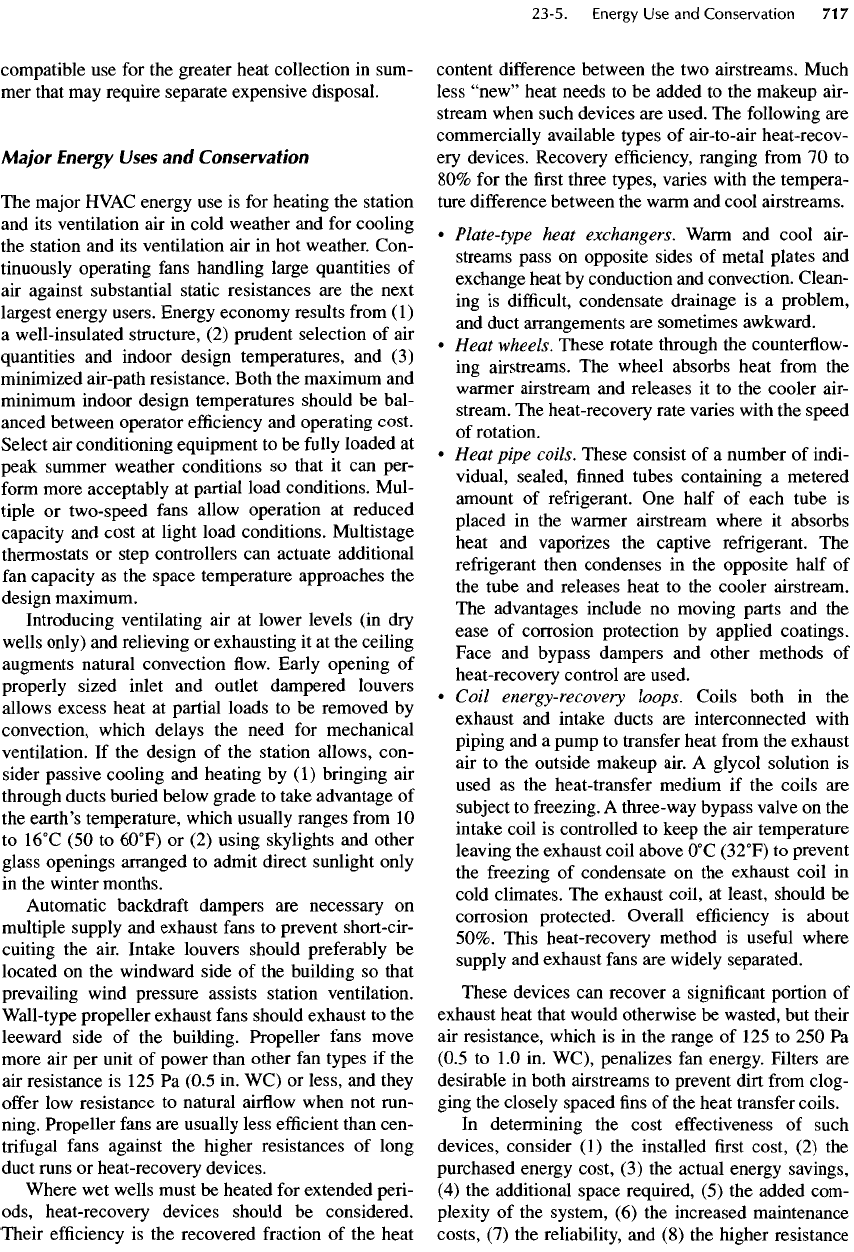
compatible
use for the
greater heat collection
in
sum-
mer
that
may
require separate expensive disposal.
Major
Energy
Uses
and
Conservation
The
major
HVAC
energy
use is for
heating
the
station
and
its
ventilation
air in
cold weather
and for
cooling
the
station
and its
ventilation
air in hot
weather. Con-
tinuously
operating
fans
handling large quantities
of
air
against substantial static resistances
are the
next
largest energy users. Energy economy results
from
(1)
a
well-insulated structure,
(2)
prudent selection
of air
quantities
and
indoor design temperatures,
and (3)
minimized
air-path resistance. Both
the
maximum
and
minimum
indoor design temperatures should
be
bal-
anced between operator
efficiency
and
operating cost.
Select
air
conditioning equipment
to be
fully
loaded
at
peak summer weather conditions
so
that
it can
per-
form
more acceptably
at
partial load conditions. Mul-
tiple
or
two-
speed
fans
allow operation
at
reduced
capacity
and
cost
at
light load conditions. Multistage
thermostats
or
step controllers
can
actuate additional
fan
capacity
as the
space temperature approaches
the
design maximum.
Introducing
ventilating
air at
lower levels
(in dry
wells only)
and
relieving
or
exhausting
it at the
ceiling
augments
natural convection
flow.
Early opening
of
properly sized inlet
and
outlet dampered louvers
allows excess heat
at
partial loads
to be
removed
by
convection, which delays
the
need
for
mechanical
ventilation.
If the
design
of the
station allows, con-
sider passive cooling
and
heating
by (1)
bringing
air
through
ducts buried below grade
to
take advantage
of
the
earth's temperature, which usually ranges
from
10
to
16
0
C
(50 to
6O
0
F)
or (2)
using skylights
and
other
glass openings arranged
to
admit direct sunlight only
in
the
winter months.
Automatic
backdraft
dampers
are
necessary
on
multiple
supply
and
exhaust
fans
to
prevent short-cir-
cuiting
the
air. Intake louvers should preferably
be
located
on the
windward side
of the
building
so
that
prevailing
wind pressure assists station ventilation.
Wall-type propeller exhaust
fans
should exhaust
to the
leeward
side
of the
building. Propeller
fans
move
more
air per
unit
of
power than other
fan
types
if the
air
resistance
is 125 Pa
(0.5
in. WC) or
less,
and
they
offer
low
resistance
to
natural
airflow
when
not
run-
ning.
Propeller
fans
are
usually
less
efficient
than cen-
trifugal
fans
against
the
higher resistances
of
long
duct
runs
or
heat-recovery devices.
Where
wet
wells must
be
heated
for
extended peri-
ods, heat-recovery devices should
be
considered.
Their
efficiency
is the
recovered
fraction
of the
heat
content
difference
between
the two
airstreams. Much
less
"new"
heat needs
to be
added
to the
makeup air-
stream when such devices
are
used.
The
following
are
commercially available types
of
air-to-air heat-recov-
ery
devices. Recovery
efficiency,
ranging
from
70 to
80% for the first
three types, varies
with
the
tempera-
ture
difference
between
the
warm
and
cool airstreams.
•
Plate-type
heat exchangers. Warm
and
cool air-
streams pass
on
opposite
sides
of
metal plates
and
exchange heat
by
conduction
and
convection. Clean-
ing
is
difficult,
condensate drainage
is a
problem,
and
duct arrangements
are
sometimes awkward.
•
Heat
wheels.
These rotate through
the
counterflow-
ing
airstreams.
The
wheel absorbs heat
from
the
warmer
airstream
and
releases
it to the
cooler air-
stream.
The
heat-recovery rate varies with
the
speed
of
rotation.
•
Heat pipe coils. These consist
of a
number
of
indi-
vidual,
sealed,
finned
tubes containing
a
metered
amount
of
refrigerant.
One
half
of
each tube
is
placed
in the
wanner airstream where
it
absorbs
heat
and
vaporizes
the
captive refrigerant.
The
refrigerant then condenses
in the
opposite half
of
the
tube
and
releases heat
to the
cooler airstream.
The
advantages include
no
moving parts
and the
ease
of
corrosion protection
by
applied coatings.
Face
and
bypass dampers
and
other methods
of
heat-recovery control
are
used.
•
Coil
energy-recovery
loops. Coils both
in the
exhaust
and
intake ducts
are
interconnected with
piping
and a
pump
to
transfer heat
from
the
exhaust
air to the
outside makeup air.
A
glycol solution
is
used
as the
heat-transfer medium
if the
coils
are
subject
to
freezing.
A
three-way bypass valve
on the
intake coil
is
controlled
to
keep
the air
temperature
leaving
the
exhaust coil above
O
0
C
(32
0
F)
to
prevent
the
freezing
of
condensate
on the
exhaust coil
in
cold climates.
The
exhaust
coil,
at
least, should
be
corrosion protected. Overall
efficiency
is
about
50%. This heat-recovery method
is
useful
where
supply
and
exhaust
fans
are
widely separated.
These devices
can
recover
a
significant
portion
of
exhaust heat that would otherwise
be
wasted,
but
their
air
resistance, which
is in the
range
of 125 to 250 Pa
(0.5
to 1.0 in.
WC), penalizes
fan
energy. Filters
are
desirable
in
both airstreams
to
prevent dirt
from
clog-
ging
the
closely spaced
fins of the
heat transfer coils.
In
determining
the
cost
effectiveness
of
such
devices, consider
(1) the
installed
first
cost,
(2) the
purchased energy cost,
(3) the
actual energy savings,
(4)
the
additional space required,
(5) the
added com-
plexity
of the
system,
(6) the
increased maintenance
costs,
(7) the
reliability,
and (8) the
higher resistance
